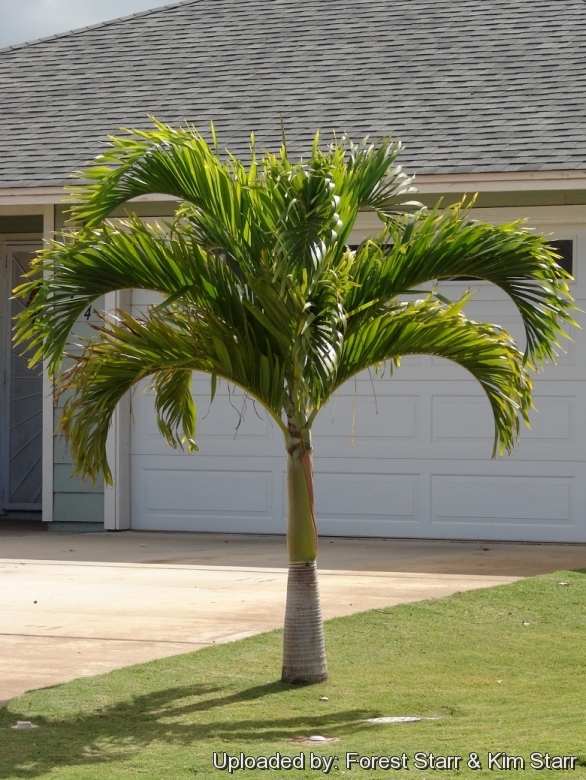
Adonidia merrillii Photo by: Forest Starr & Kim Starr
Habit at Piilani Villages Kihei, Maui, Hawaii (USA). January 23, 2007.
Origin and Habitat: Palawan Island, Philippines and northern Borneo, but widely cultivated in tropical countries such as Hawaii and Florida.
Habitat: It grows in coastal areas in open forest found on steep limestone soils.
Synonyms:
Common Names include:
ENGLISH: Dwarf Royal Palm, Manila palm, Christmas palm
CHINESE (中文): Ma ni la ye zi
DUTCH (Nederlands): Kerstpalm
FRENCH (Français): Palmier de Noel, Palmier de Manille
GERMAN (Deutsch): Weihnachtspalme
JAPANESE (日本語): Manira yashi
MALAY (بهاس ملاي /Bahasa Melayu ): Palma Manila
SPANISH (Español): Palma de Manila, Palma Manila, Palma de Navidad
THAI (ภาษาไทย): Paam nuan, Maak nuan
Description: Adonidia merrilliiSN|24738]]SN|24738]] is a popular small to medium-sized, single-trunked palm tree that resembles a dwarf version of the royal palm (Roystonea regiaSN|24657]]SN|24657]]) which it matches in beauty if not in size. Christmas palm grows to an overall height of about 4,5-7,5 m, though often much shorter (but some specimens have attained 25 m of height). It is often confused with Ptychosperma elegansSN|28637]]SN|28637]].
Stem: Single, upright, slender, resistant, grey, smooth, sectioned by semi-circular leaf scars, 25-30 cm in diameter and swollen at the base. The trunk is self cleaning of old leaves.
Crown shaft: Neatly umbrella-like compact with about 12-14 leaves growing alternate and in spiral with delightful symmetry and with a frond spread about 2-3 m.
Leaves: Odd pinnately compound, with a short tomentose petiole and stiffly arching rachis, evergreen, smooth, deep-green, and about 1.5-1,8 m long with strap-shaped to lanceolate leaflets that are about 60 cm long and 5 cm wide and held in a decidedly V-shaped angle, grow in several planes from the base to about the midpoint of the leaf; then toward the apex, in a single plane; Margin entire; leaflet venation parallel. Leaflet tips are irregularly jagged.
Inflorescence: About 60 cm long from the point at which the crownshaft attaches to the trunk.
Flowers: Small, inconspicuous and not showy, greyish-green to butter-cream coloured. Male and female producing flowers are separate, although they are both present in a single inflorescence. Staminate (male) flowers can contain up to 200 anthers in which the pollen is produced.
Blooming season: Summer.
Fruit: In large bunches, ovoid, fleshy, 3 cm long and half as wide and contain a single seed.
Fruiting period (northern emisphere): The light-green unripened fruits (in autumn) gradually turns to a glossy and brilliant scarlet-red and tend to be that colour in winter, hence the common name Christmas palm. In many tropical countries, these fruits are seen frequently throughout the year.
Bibliography: Major references and further lectures
1) Forest & Kim Starr Veitchia merrillii (Manila palm, Christmas palm). Plants of Hawaii. <http://www.starrenvironmental.com>. Downloaded on 21 August 2014.
2) Michael J. Balick, Hans T. Beck “Useful Palms of the World” Columbia University Press 1990
3) Jack Krempin “Palms & Cycads Around the World” Horwitz Grahame, 1990
4) Wikipedia contributors. "Adonidia merrillii ." Wikipedia, The Free Encyclopedia. Wikipedia, The Free Encyclopedia, 8 Sep. 2014. Web. 11 Sep. 2014.
5) John Dransfield, Natalie W. Uhl “Genera Palmarum: the evolution and classification of palms” Kew Pub., 2008
6) Don Ellison, Anthony Ellison “Cultivated Palms Of The World” UNSW Press, 01/May/2001
7) Govaerts, R. & Dransfield, J. “World Checklist of Palms”. The Board of Trustees of the Royal Botanic Gardens, Kew. 2005.
8) Palmpedia contributors. "Adonidia merrillii " Palmpedia, PALM ENCYCLOPEDIA, <http://www.palmpedia.net> Downloaded on 26 Aug. 2014
9) Robert Lee Riffle, Paul Craft “An Encyclopedia of Cultivated Palms” Timber Press, Portland 2007
10) "Adonidia merrillii." PACSOA Palms and Cycads wiki , <http://www.pacsoa.org.au> Accessed on 28 Aug. 2014
11) Dieter Mueller-Dombois “Vegetation of the Tropical Pacific Islands” Springer Science & Business Media, 1998
12) Neil G. Odenwald, James R. Turner "Identification, Selection, and Use of Southern Plants for Landscape Design" Claitor's Law Books and Publishing, 2006
13) T. Kent Kirk "Tropical Trees of Florida and the Virgin Islands: A Guide to Identification, Characteristics and Uses" Pineapple Press Inc, 2009
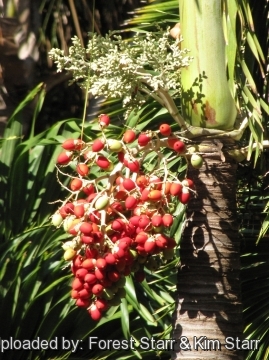 Fruit at Resort Management Group Nursery Kihei, Maui. February 09, 2011. Photo by: Forest Starr & Kim Starr
Fruit at Resort Management Group Nursery Kihei, Maui. February 09, 2011. Photo by: Forest Starr & Kim Starr Habit at Kihei, Maui, Hawaii (USA). January 24, 2007. Photo by: Forest Starr & Kim Starr
Habit at Kihei, Maui, Hawaii (USA). January 24, 2007. Photo by: Forest Starr & Kim Starr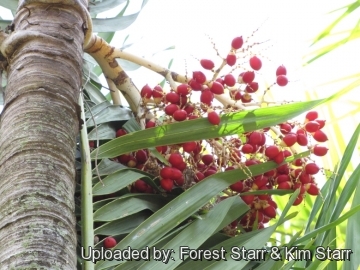 Fruit at Iao Tropical Gardens of Maui, Maui, Hawaii (USA). May 22, 2012. Photo by: Forest Starr & Kim Starr
Fruit at Iao Tropical Gardens of Maui, Maui, Hawaii (USA). May 22, 2012. Photo by: Forest Starr & Kim Starr Inflorescence at Makawao Veterinary Clinic, Maui, Hawaii (USA). September 28, 2006. Photo by: Forest Starr & Kim Starr
Inflorescence at Makawao Veterinary Clinic, Maui, Hawaii (USA). September 28, 2006. Photo by: Forest Starr & Kim Starr Frond at Kula Ace Hardware and Nursery, Maui, Hawaii (USA). September 06, 2007. Photo by: Forest Starr & Kim Starr
Frond at Kula Ace Hardware and Nursery, Maui, Hawaii (USA). September 06, 2007. Photo by: Forest Starr & Kim Starr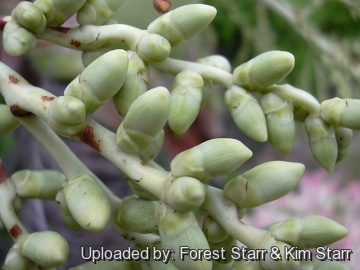 Inflorescence at Makawao Veterinary Clinic, Maui, Hawaii (USA). September 28, 2006. Photo by: Forest Starr & Kim Starr
Inflorescence at Makawao Veterinary Clinic, Maui, Hawaii (USA). September 28, 2006. Photo by: Forest Starr & Kim Starr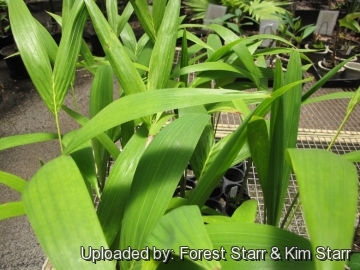 In pots at Iao Tropical Gardens of Maui, Maui; Hawaii (USA). May 22, 2012. Photo by: Forest Starr & Kim Starr
In pots at Iao Tropical Gardens of Maui, Maui; Hawaii (USA). May 22, 2012. Photo by: Forest Starr & Kim Starr Habit at Holiday Inn Express Boynton Beach, Florida. September 23, 2009. Photo by: Forest Starr & Kim Starr
Habit at Holiday Inn Express Boynton Beach, Florida. September 23, 2009. Photo by: Forest Starr & Kim StarrCultivation and Propagation: This palm is an excellent fast growing garden plant suitable for well-drained soils (clay; loam; sand; slightly alkaline or acidic) except those that are constantly soggy and practically thrive on neglect. Surface roots are usually not a problem. If home-grown, give some sun as with most tropical palms, and water well and feed once monthly.
Light: Prefers full sun but will take some shade.
Drought tolerance: Moderate. This palm appreciates regular waterings but will tolerate periods of drought if not prolonged.
Hardiness: Very cold sensitive, and so it is only really suited to the tropics in frost-free regions (USDA Zones 10-12)
Aerosol salt tolerance: It is moderately salt tolerant.
Maintenance: Remove dried fronds.
Propagation: Fresh seeds germinate quickly within 1 to 3 months and the seedlings are attractive.
Use: Its very neat appearance and stature makes it perfect for use in courtyards, atriums, terrace, specimen and close to swimming pools. It is sometimes closely planted in groups of two or three. Spectacular, when grown as a landscape palm along streets or sidewalks, highways, roadsides, roundabouts and road dividers. It is also used as an indoor décor plant in homes, offices and shops.
Disease & Pests: Hardly bothered by diseases and pests this palm is susceptible to the disease lethal yellowing in certain regions, like Florida and Texas for which there is no effective treatment. Scales can infest and spoil young palms. Lethal Yellowing is thought to be caused by organisms called mycoplasmas that are transmitted by the American palm cixiid, Myndus crudus.
Your Photos

by Forest Starr & Kim Starr


















